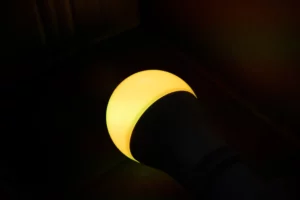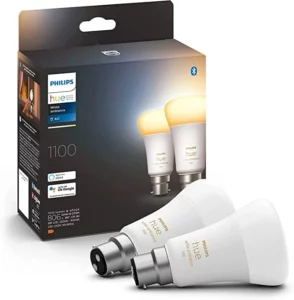The emergence of smart light bulbs has revolutionized indoor lighting, but can they also be employed outdoors? Interestingly, there are compelling reasons to utilize smart light bulbs in outdoor settings, unlocking the same advantages witnessed with indoor smart lighting while significantly enhancing their value. By incorporating outdoor smart lights, you can augment the security and safety of your home exterior, replicating the benefits experienced indoors.
The good news is, indeed, smart light bulbs can be used outdoors. To achieve this, you have two options. Firstly, you can install a coach light sconce, providing a degree of protection for your smart light bulbs, allowing them to thrive in an outdoor environment. Alternatively, you can opt for smart bulbs specifically designed for outdoor use, ensuring their durability and resilience to outdoor conditions.
With the seamless integration of outdoor smart lights, you’ll be plugged into the illuminating world of enhanced outdoor lighting, empowering you to create a safer and more secure outdoor space, just as you did indoors with smart lighting technology.
Can You Use Regular Smart Bulbs Outside?
Indeed, using everyday indoor smart bulbs outdoors poses certain risks and challenges. While it might be possible to use them outside under specific circumstances, it’s essential to understand the limitations and potential issues that may arise.

Standard smart bulbs are not designed to endure constant exposure to outdoor elements, with water being one of the most significant threats to their functionality. These bulbs are not built to withstand moist environments, making them unsuitable for outdoor use where rain, snow, ice, and humidity can be prevalent.
Moreover, exposure to extreme temperatures and direct sunlight can further affect the durability and longevity of indoor smart bulbs when used outdoors. The combination of these environmental factors can lead to damage and reduced performance.
Although some workarounds may enable the use of regular smart bulbs outside, it’s crucial to consider their limitations and vulnerabilities. For reliable outdoor smart lighting, it is best to opt for weatherproof smart bulbs explicitly designed and built to withstand outdoor conditions, providing enhanced performance and longevity.
What Does Weather Sealing Does for Smart Bulbs?
Weather sealing is a crucial aspect of outdoor smart technology, and it primarily involves protecting the device’s internal components from water and other outdoor elements. While the appearance of weatherproof outdoor devices may not differ significantly from their indoor counterparts, the difference lies in the internal mechanisms and design.

The key to weatherproofing lies in the implementation of watertight gaskets inside the device. These gaskets create a seal that prevents water from entering the housing and coming into contact with the electronic components. As long as the internal components are shielded from water, the outdoor smart technology can withstand various weather conditions without compromising its performance or longevity.
An excellent example of weatherproofing can be observed in devices like the Ring Floodlight Cam. In this case, the LED arms and the entire device are well-protected from the elements with sealed front-facing glass and weatherproofed surroundings. Additionally, rubber grommets are used on the back bracket to safeguard the entry holes for the wire and screws from water ingress.
Using indoor smart bulbs in an outdoor setting can be a gamble, as they are not designed to withstand exposure to water and outdoor conditions. While some people may experience limited success in such scenarios, others have faced bulb damage or failure shortly after exposure to the elements.
To identify if a smart bulb is weather-sealed, it’s crucial to check the manufacturer’s specifications and product descriptions. Weatherproof outdoor smart bulbs are explicitly designed and labeled for outdoor use, offering a reliable and safe option for outdoor lighting needs.
How To Know Bulb is Weather Sealed?
If you want to avoid taking chances with your outdoor lights and ensure they can withstand the weather, it’s essential to determine whether they are weather-resistant. While some manufacturers may market their lights as “water-resistant” or “weather-resistant,” these terms can be somewhat misleading and not tightly regulated.
To truly assess a device’s ability to withstand outdoor conditions, look for an IP (Ingress Protection) rating. IP ratings are standardized codes that indicate the level of protection a device has against solids and liquids. The rating consists of two digits: the first digit represents the device’s protection against solid objects like dust, while the second digit signifies its protection against liquids, including water.

Here’s how to interpret IP ratings:
- The first digit (0-6): This digit indicates the level of protection against solid objects, with higher numbers offering better protection against dust and debris. For example, a rating of 0 means no protection against solids, while a rating of 6 signifies complete protection against dust.
- The second digit (0-9): This digit indicates the device’s protection against liquids, particularly water. A higher number indicates a higher level of protection against water. For example, a rating of 0 means no protection against water, while a rating of 9 indicates protection against powerful water jets.
For outdoor lights, look for IP ratings such as IP65, IP66, IP67, or IP68, which indicate varying levels of weather resistance. A higher IP rating means the light is better protected against dust and water, making it suitable for outdoor use in different weather conditions.
By paying attention to the IP rating, you can confidently choose weather-resistant lights that will endure the elements and provide reliable outdoor illumination.
Reading Waterproofing Standards
When shopping for outdoor smart lights, you’ll likely come across IP ratings, which stand for Ingress Protection or International Protection Rating. These ratings determine the device’s resistance to dust and water, providing essential information about its capabilities in different outdoor conditions.
The IP rating is comprised of two digits. The first digit indicates the dust protection level, ranging from 0 (no protection) to 6 (totally dust sealed and vacuum tested). The second digit represents the water protection level, ranging from 0 (no protection) to 9 (resistance to high-pressure water and steam). In some cases, the highest water protection rating of 9 is denoted by the letter “K” instead of the number 9.
For instance, a smart light with an IP44 rating offers mid-range protection, suitable for withstanding snow, rain, and occasional storms. On the other hand, devices like the Ring Floodlight Cam boast a higher IP65 rating, providing additional protection against dust and water.
There’s also the “X” rating, which means that the device was not tested for a specific protection level. For instance, an IPX4 rating would indicate a water resistance rating of 4 but without a specific dust resistance test. In practice, the “X” is often treated as equivalent to “0” for dust protection.
By understanding these IP ratings, you can easily navigate through marketing jargon and make informed decisions while choosing the right outdoor smart lights that perfectly suit your needs.
How To Use Regular Smart Bulbs Outside?
In the early days of the Internet of Things, smart home technology was more of a do-it-yourself (DIY) experience, requiring creative workarounds to adapt indoor smart bulbs for outdoor use. If you’re eager to explore some DIY action, here’s a quick workaround that can make your indoor smart bulbs safe for even the rainiest outdoor climates.

The secret lies in your outdoor decor.
By changing the type of sconce in which your outdoor light is installed, you can provide weatherproofing for your smart bulbs. A coach light sconce is the ideal choice as it offers a protective outer casing that helps prevent water from reaching the light bulb:
Coach lights come in various styles, from old-school Victorian flair to modern designs, ensuring you can find one that complements your home’s style.
All you need to do is install your regular smart bulbs into the coach light of your choice, providing them with a decent level of protection against the elements. However, it’s important to note that this method may not offer complete protection from water, depending on the specific coach light brand, installation location, and local weather conditions.
While this DIY solution works in many cases, if your area experiences extreme rainy weather, you may need to consider investing in dedicated outdoor smart bulbs designed explicitly for robust weather resistance.
Using Dedicated Outdoor Smart Lights
Philips Hue offers a range of outdoor lighting solutions that address your outdoor lighting needs straight out of the box.
The Fuzo Outdoor Wall Light is compatible with Hue’s bridge and comes with its own sconce, eliminating the need to worry about fitting it into your current outdoor decor. Its understated and minimalist design allows it to seamlessly blend with almost any style. Moreover, the Fuzo Outdoor Wall Light boasts an impressive IP44 rating, making it highly resistant to rainy climates. With a variety of styles available, you can easily find one that complements your outdoor decor.
For a classic floodlight option, Philips Hue presents the Outdoor Welcome light. This outdoor smart light serves as an excellent choice to illuminate your backyard or garage area.
In addition to wall lights and floodlights, Philips Hue offers a range of smart bulbs explicitly designed for outdoor use. This comprehensive collection includes standard light bulbs as well as larger lights that offer more significant illumination.
If you’re looking for tasteful under lighting to enhance your patio ambiance, there’s another Hue product that is well-suited for outdoor applications.
With Philips Hue’s outdoor lighting range, you can effortlessly elevate your outdoor spaces while enjoying the convenience and smart features of their innovative lighting solutions.

Wrapping it up
Philips Hue offers the Hue Outdoor Light Strip, which boasts the company’s best IP rating of IP67. This LED light strip is exceptionally weather-resistant, making it suitable for rough weather conditions, outperforming your average siding.
The Hue Outdoor Light Strip is available in 2-meter and 5-meter strips, offering both white and color light options. It serves as an excellent choice for adding ambient lighting and more detailed illumination to your outdoor spaces. Moreover, its versatility makes it a smart option for holiday lighting, suitable for occasions ranging from Valentine’s Day to Halloween.
A newer alternative in the market is Ring, previously known for their smart doorbells but now expanding into smart lighting. Ring offers a variety of outdoor light bulbs, such as the Ring PAR38, designed to fit standard 120-watt sockets. These bulbs are suitable for various climates and can be paired with the Ring app and other compatible devices. Additionally, Ring provides outdoor floodlights and sconces that rival Philips Hue’s offerings.
For those interested in Ring’s smart lighting range, it’s essential to note that just like the Philips Hue lights requiring a Hue Bridge, Ring’s smart lights require a Ring Bridge to function properly.
Both Philips Hue and Ring offer excellent options for outdoor smart lighting, allowing you to elevate and enhance your outdoor spaces with innovative and weather-resistant lighting solutions.
You May Also Enjoy Reading: Can Smart LED Light Strips & Bulbs SPY On You?

